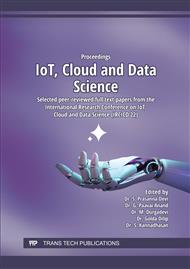[1]
Shinichi Tamura and Shingo Kawasaki. 1988. Recognition of Sign Language Motion Images. Pattern Recognition 21, 4 (1988), 343–353.
DOI: 10.1016/0031-3203(88)90048-9
Google Scholar
[2]
R.-H. Liang and M. Ouhyoung, ``A sign language recognition system using hidden Markov model and context-sensitive search,, in Proc. ACM Symp. Virtual Reality Softw. Technol. (VRST), 1996, pp. 59_66.
DOI: 10.1145/3304181.3304194
Google Scholar
[3]
M. M. Zaki and S. I. Shaheen, ``Sign language recognition using a combination of new vision-based features,, Pattern Recognit. Lett., vol. 32, no. 4, pp. 572_577, (2011).
DOI: 10.1016/j.patrec.2010.11.013
Google Scholar
[4]
O. Koller, H. Ney, and R. Bowden, ``Deep hand: How to train a CNN on 1 million hand images when your data is continuous and weakly labelled,, in Proc. IEEE Conf. Comput. Vis. Pattern Recognit. (CVPR), Jun. 2016, pp. 3793_3802.
DOI: 10.1109/cvpr.2016.412
Google Scholar
[5]
R. Cui, H. Liu, and C. Zhang, ``A deep neural framework for continuous sign language recognition by iterative training,, IEEE Trans. Multimedia, vol. 21, no. 7, pp. 1880_1891, Jul. (2019).
DOI: 10.1109/tmm.2018.2889563
Google Scholar
[6]
Li, Shao-Zi; Yu, Bin; Wu, Wei; Su, Song-Zhi; Ji, Rong-Rong (2015). Feature learning based on SAE–PCA network for human gesture recognition in RGBD images. Neurocomputing, 151(), 565–573.
DOI: 10.1016/j.neucom.2014.06.086
Google Scholar
[7]
Huang, Jie; Zhou, Wengang; Li, Houqiang; Li, Weiping (2018). Attention-based 3D-CNNs for Large-Vocabulary Sign Language Recognition. IEEE Transactions on Circuits and Systems for Video Technology, (), 1–1.
DOI: 10.1109/icme.2015.7177428
Google Scholar
[8]
Facial Expression Recognition Using Support Vector Machines Philipp Michel and Rana El Kaliouby Computer Laboratory University of Cambridge Cambridge CB3 0FD, U.K.
Google Scholar
[9]
Bajpai, Anvita. (2010). Real-time Facial Emotion Detection using Support Vector Machines. International Journal of Advanced Computer Science and Applications. 1. 10.14569/IJACSA.2010. 010207.
DOI: 10.14569/ijacsa.2010.010207
Google Scholar
[10]
Tadese Henok Seifu, 2022, Automated Facial Expression Recognition using SVM and CNN, International Journal of Engineering Research & Technology (IJERT) Volume 11, Issue 03 (March 2022).
Google Scholar
[11]
O. Koller, H. Ney and R. Bowden, Deep Hand: How to Train a CNN on 1 Million Hand Images When Your Data is Continuous and Weakly Labelled,, 2016 IEEE Conference on Computer Vision and Pattern Recognition (CVPR), 2016, pp.3793-3802,.
DOI: 10.1109/cvpr.2016.412
Google Scholar
[12]
M. Ma, X. Xu, J. Wu and M. Guo, Design and analyze the structure based on deep belief network for gesture recognition,, 2018 Tenth International Conference on Advanced Computational Intelligence (ICACI), 2018, pp.40-44,.
DOI: 10.1109/icaci.2018.8377544
Google Scholar
[13]
Erde Rakun1, Antietam. Arymurthy1, Lim Y. Stefanus1, Alfan F. Wicaksono, I Wayan W. Wisesa1 Recognition of Sign Language System for Indonesian Language using Long Short-Term Memory Neural Networks,.
Google Scholar
[14]
D. Guo, W. Zhou, A. Li, H. Li and M. Wang, Hierarchical Recurrent Deep Fusion Using Adaptive Clip Summarization for Sign Language Translation,, in IEEE Transactions on Image Processing, vol. 29, pp.1575-1590, 2020,.
DOI: 10.1109/tip.2019.2941267
Google Scholar
[15]
G. A. R. Kumar, R. K. Kumar and G. Sanyal, Facial emotion analysis using deep convolution neural network,, 2017 International Conference on Signal Processing and Communication (ICSPC), 2017, pp.369-374,.
DOI: 10.1109/cspc.2017.8305872
Google Scholar
[16]
E. Pranav, S. Kamal, C. Satheesh Chandran and M. H. Supriya, Facial Emotion Recognition Using Deep Convolutional Neural Network,, 2020 6th International Conference on Advanced Computing and Communication Systems (ICACCS), 2020, pp.317-320,.
DOI: 10.1109/icaccs48705.2020.9074302
Google Scholar
[17]
Verma, P. Singh and J. S. Rani Alex, Modified Convolutional Neural Network Architecture Analysis for Facial Emotion Recognition,, 2019 International Conference on systems, Signals and Image Processing (IWSSIP), 2019, pp.169-173,.
DOI: 10.1109/iwssip.2019.8787215
Google Scholar


